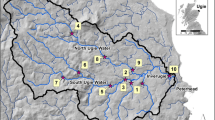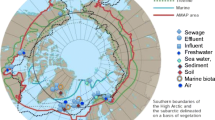Abstract
Goal, Scope and Background
In the past few years, there was an increasing awareness of the occurrence of pharmaceuticals and personal care products (PPCPs) in surface water and drinking water resources, and measurements in surface water, sediment or waste water were done for a number of PPCPs. In the regulatory context, an environmental risk assessment (ERA) has become essential for new PPCPs. Reliably predicted or measured environmental concentrations (PECs or MECs) of chemicals are essential for the exposure assessment, which is one of the two main pillars of environmental risk assessment (ERA). This paper reports on measured data of selected PPCPs in surface waters and compares the measured values with predicted environmental concentrations from exposure models. Such models have been proposed by the European Agency for the Evaluation of Medicinal Products (EMEA) and the Technical Guidance Document on Risk Assessment for New Notified and Existing Chemical Substances (TGD).
Methods
Four pharmaceuticals and one personal care product were in the scope of the investigation reported here: 17α-ethinylestradiol, carbamazepine, sulfamethoxazole and iopromide as well as tonalide. Measured environmental concentrations in surface waters for these PPCPs were reviewed in the scientific literature. The appropriateness of these data was evaluated according to criteria for monitoring data recommended by the TGD. A total of 38 references were evaluated with emphasis on the adequacy of chemical analysis and the representativeness of sampling. Measurements of concentrations in surface water (MECsw), which were found to be adequate for use in exposure assessment according to the monitoring quality criteria, were averaged and compared with respective PECs in surface water (PECsw) derived from exposure modelling (cf. EMEA and TGD).
Results and Discussion
Measured environmental concentrations adequate for use in exposure assessment were found in 20 out of 38 references. Several of the measurements from Germany could be used for a comparison with calculated PECs. Average MECssw in Germany were < 0.58 ng/L for 17α-ethinylestradiol, 454 ng/L for carbamazepine, 126 ng/L for sulfamethoxazole, 1105 ng/L for iopromide and 311 ng/L for tonalide. In comparison to the measured concentrations, PECs calculated with the model proposed by the EMEA in 2001 were in the same range, but slightly higher than the MECs. The EMEA model from 2001 is based on a production/use volume of the PPCPs. The more recent EMEA model (2003/2005) overestimated the PECs by more than one order of magnitude for carbamazepine and sulfamethoxazole, but underestimated the concentration of 17α-ethinylestradiol by a factor of almost 5 compared to the MECs. This model is based on maximum daily doses and the assumption that 1% of the population is consuming the pharmaceutical (default value). Calculations with the European Union System for the Evaluation of Substances (EUSES), which is part of the TGD describing the risk assessment of chemicals and biocides, resulted for the investigated pharmaceuticals in almost the same PECs as derived by the older EMEA model (2001). For the PCP tonalide, to which the recent EMEA model (2003/2005) cannot be applied, the PEC was overestimated by a factor of 3 with the older EMEA model (2001), but underestimated with EUSES by a factor of 5 compared to the averaged MECsw in Germany.
Conclusions
It was shown that PEC calculations with exposure models provided by EMEA and the TGD, resulted in PECs very close to the corresponding MECs in most cases. However, environmental concentrations can be underestimated by models in cases, where, e.g. due to high lipophilicity, sorption to sewage sludge is assumed which does not occur to that extent under real conditions. Thus, it appears that the exposure models do not come up to the complexity of the real environment. However, the main factor with the highest impact on predicted environmental concentrations and a high degree of uncertainty is the production volume.
Recommendations and Outlook
References and their data evaluated as not adequate for use in exposure assessment were mainly rejected due to missing or insufficient specifications related to the sampling procedure and/or representativeness of the samples. Several of the evaluated studies aimed at the introduction and establishment of a new analytical methodology. A detailed description of sampling frequency and pattern, for example, was therefore neglected. Often, a more accurate description of analytical procedure, sampling pattern and statistical analysis of data would be sufficient to provide an adequate basis for exposure assessment and hence establish confidence in environmental risk assessment procedures. For new substances, an exposure assessment is solely based on estimations using environmental fate models. To avoid unacceptable risks for the environment, PECs should not underestimate actual environmental concentrations. Since it was shown that under specific conditions the models applied in this study underestimated measured environmental concentrations, further development of the calculation models appears to be necessary.
Similar content being viewed by others
Author information
Authors and Affiliations
Corresponding authors
Rights and permissions
About this article
Cite this article
Liebig, M., Moltmann, J. & Knacker, T. Evaluation of Measured and Predicted Environmental Concentrations of Selected Human Pharmaceuticals and Personal Care Products (10 pp). Env Sci Poll Res Int 13, 110–119 (2006). https://doi.org/10.1065/espr2005.08.276
Received:
Accepted:
Published:
Issue Date:
DOI: https://doi.org/10.1065/espr2005.08.276




